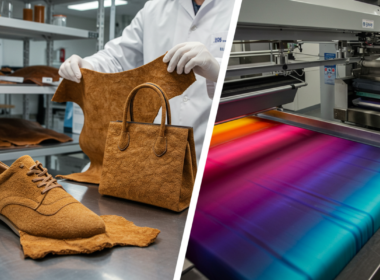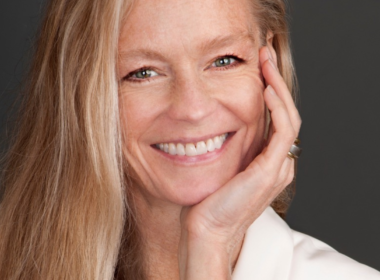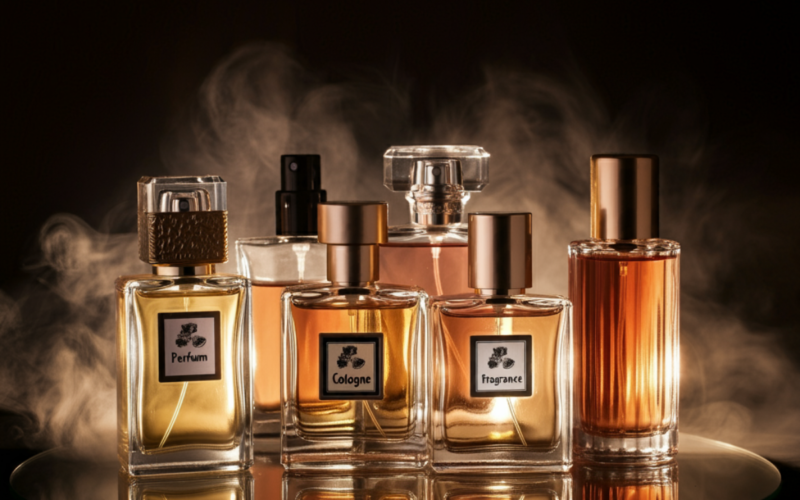In the final part of our conversation with Gerald Chukwuma, we take a deep dive into his vision for the future of Nigerian art and his personal legacy. Gerald Chukwuma reflects on his artistic evolution, the significance of collaboration in the art world, and his dream of merging traditional Nigerian culture with modern architectural forms. As he continues to inspire the next generation of artists, Gerald Chukwuma shares what drives him to leave a lasting impact on both local and global art scenes.
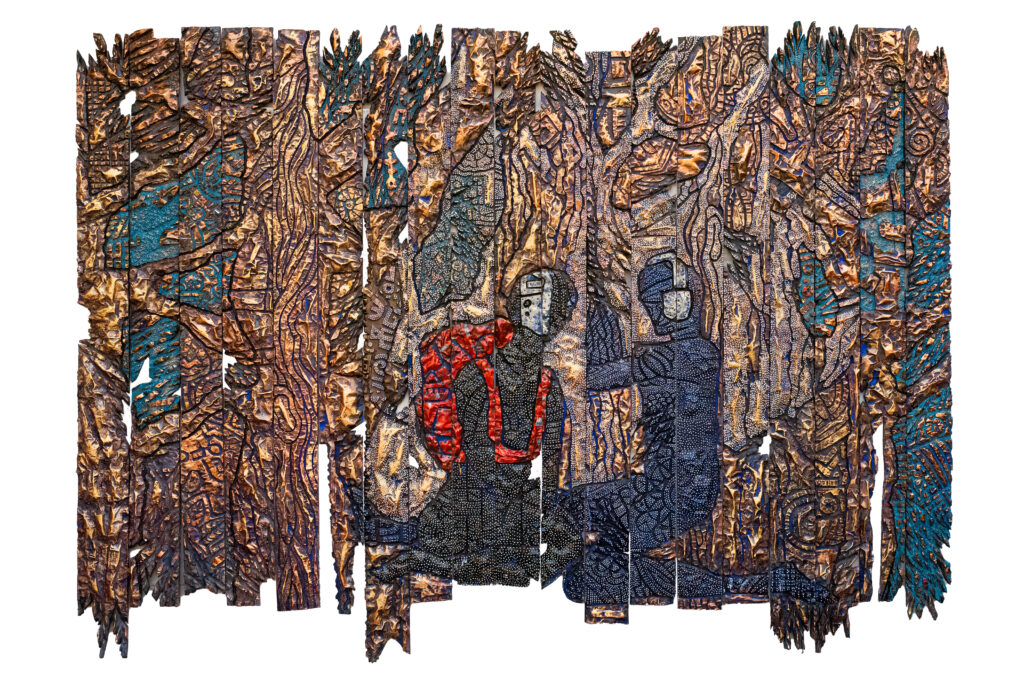
FAB: In Nigeria, or even Africa as a whole, how do you see the art industry evolving? Do you think we’re moving in the right direction, or do you feel like we’re still stuck in the same place?
Gerald: Should I be nice or truthful?
FAB: Be truthful, of course.
Gerald: Honestly, I’m a bit concerned. Whenever people try to step outside the traditional boundaries of art in Nigeria, the gatekeepers make it seem like you’re straying too far from the norm. And that’s uncomfortable. There’s a lot of control involved. Yes, we’ve expanded somewhat—we now have performance art—but it’s still within the same confined areas.
I understand what you’re saying about wearable art, but we’re missing out on industries like that because we’re not even attempting to explore them. And validation is a big part of it. The artists you’re talking about abroad have been validated in their fields. I remember the first furniture art exhibition I attended in Dubai, and I was blown away. I thought, “Wow, furniture can actually be art!” It reminded me of what I learned in school—that furniture is art. But over time, I forgot because no one around me was bold enough to say, “Let’s exhibit your furniture as art.” I’ve made furniture pieces before, but no one was willing to showcase them.
Maybe my furniture wasn’t the best, but it’s through exhibitions that we can refine what we do, separate the wheat from the chaff, and improve. That’s how I grew in my art practice. But the problem here is endorsement—no one is endorsing these things. And that lack of endorsement comes from a place of selfishness. I hate to be so blunt, but it’s the truth. People don’t want to validate new forms of art because they cling to the old ways. There’s personal validation, of course, but public validation is crucial. You need people to look at your work and say, “Wow, this is amazing, let’s exhibit this.”
I remember when Peju Alatise tried furniture art. She created some incredible pieces. But what helped was that she had validation as a hardworking and strong artist. A few people encouraged her, which pushed her forward.
I’ve created furniture too—what you see here, Gerald Chukwuma made it. It’s functional, but it’s more than just that. Every creative mind ventures into new territories, but the real challenge is getting that validation.
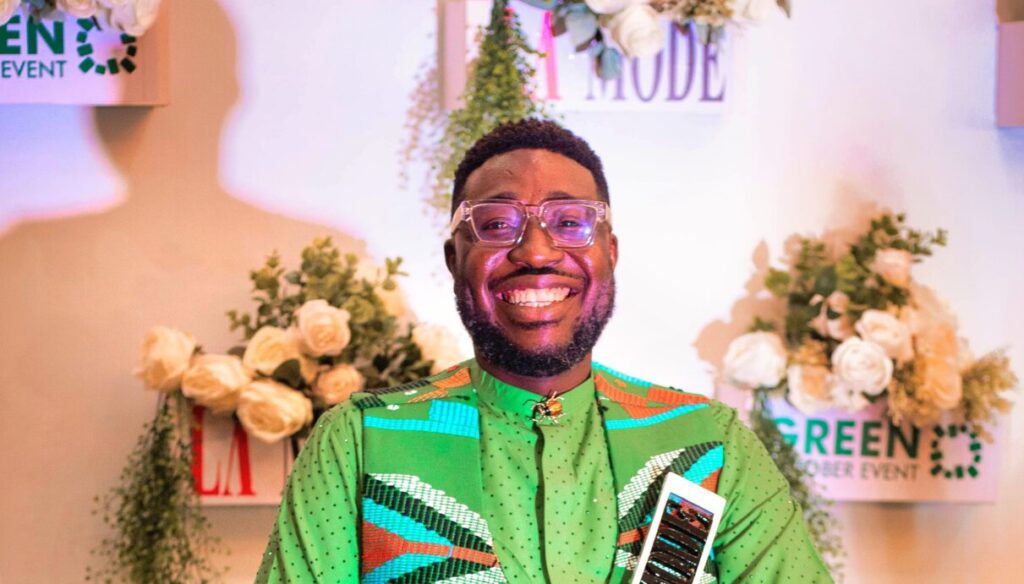
FAB: Paul Smith just collaborated with Artek for a furniture collection.
Gerald: Exactly! These days, everyone is launching their own furniture and clothing collections, trying to carve out a name for themselves. But it takes a creative team to make it happen. So, what do companies do? They bring in these creative minds and have them work for them, providing validation. That’s the only reason these collections sell.
I remember seeing a Louis Vuitton store in Milan. They had furniture on display—beautiful pieces—and flowers too, arranged so beautifully. I stood there for hours, admiring it all. It’s Louis Vuitton’s brand that validates the collection, making it desirable.
What we need is for someone like a bank to step in and sponsor a furniture exhibition, for instance. That kind of validation could kickstart the whole movement.
Unfortunately, many in the industry don’t realize how important this is. Even some of the key players don’t get it. It’s like the world of theater—without validation, there’s no audience. If there’s no recognition, people won’t show up to watch a play. It’s the same in the art world. We don’t necessarily need a huge financial investment, just a little validation from influential voices.
Wearable art, for instance, is art too. People love it. But if I want to branch out from painting and explore performance art, I wouldn’t even know where to start. That’s where we lack support. We haven’t reached that level of encouragement yet, which is unfortunate.
Let me tell you a story. Back in 2008, I met a guy while I was attending a show in the Netherlands, which was sponsored by Nigerian Breweries, by the way. We were on a plane, flying from Amsterdam to Nigeria. His name is Emmanuel Dufu. I asked him what he did before he got into art, and he told me he used to make shoes. I was surprised and asked him why he stopped. He said he didn’t think it was something worth pursuing. I was shocked. Imagine the shoes he could have created as a successful artist! Maybe those shoes would’ve been groundbreaking, perhaps even famous.
Years later, artists started drawing on shoes, and Nike commissioned some of them. I still remember telling him, “Your art could go on shoes.” Now, look at where the market is—Nike paying artists millions to design custom shoes. If he had been encouraged and validated back then, Emmanuel Dufu could have been the one leading that charge.
It all comes back to validation. Without it, so much potential goes untapped.
FAB: You’ve mentioned asking yourself when you’re going to stop. So, do you see your art evolving anytime soon? You’ve already transitioned from painting to woodwork.
Gerald: Yeah, I’ve moved through different mediums. I started with painting, then woodwork, and now I’m working with steel and metal sheets. But I’ve already decided—I’m going to take a one-year break. I need it. I know that much.
It’s funny because I’d abandoned furniture work, even though I bought machines for it. Why should I abandon it? The machines are still there, just sitting idle. But it’s in my nature to create. I love transforming materials into art, and I can’t stop doing that.
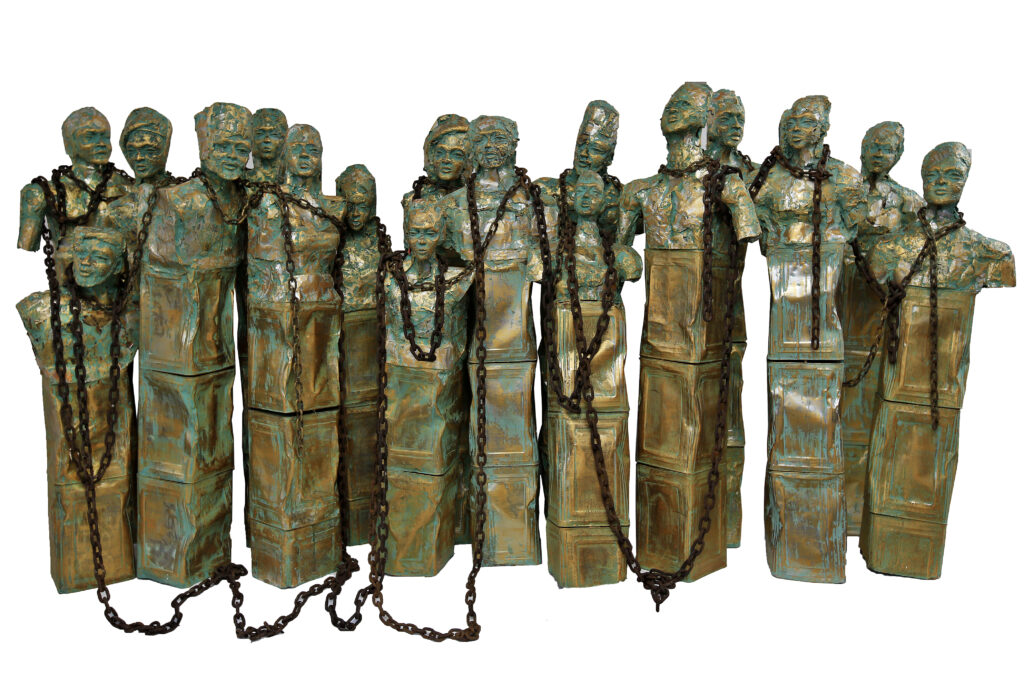
FAB: Well, your waistcoat is really nice, by the way.
Gerald: Thanks, this is Akwete fabric, and we also have Aso Oke. These are beautiful materials, and I want to work with everything. My art will evolve—I’m sure of that. I don’t care what anyone thinks anymore. My ideas are too bottled up, and I need to let them flow where they’re supposed to go.
For example, I know the woodwork will take a backseat for a while. The metalwork will probably come to the forefront, at least visually. But there’s a functional side of me that’s been suppressed for too long, and it’s starting to reawaken. I’m thinking more and more about wearable art and functional art—things that people can use and appreciate in their everyday lives, not just visually.
I’ll be taking about a year off, maybe a year and three months. Sure, I’ll be working on my studio during that time, but I won’t be actively creating. I’ll be thinking and planning because collaboration is essential for larger projects like furniture-making. It takes people, machines, and a lot of coordination.
Wearable art is definitely on my mind. If I find the right partnerships—because partnerships are key for me right now—I think we could achieve something really impactful. Imagine if a brand like Versace showcased one of these pieces. People all over the world would start talking. But it doesn’t have to be a brand like Versace. We can create something that stands on its own, that’s meaningful and accessible, something that serves a purpose.
So yeah, by this time next year, I won’t be doing the same thing I’m doing now. It’s not even possible. As we speak, I’ve already started building what I call an “inspirational center.” It’s not complete yet, but it’s going to be like a hotel where every corner is art—the floors, the ceilings, everything. It’s all about creating an experience steeped in culture. We’ve lost so much of that in Nigeria, especially with the way we build homes now. These beautiful, air-conditioned spaces—they’re soulless. They don’t reflect our culture, and that’s something I want to change.
FAB: In a previous conversation, you mentioned that art should reflect what’s happening in society. Given Nigeria’s current challenges—fuel scarcity, economic hardships—how do you see artists addressing these issues? Do you have any ongoing work that comments on them?
Gerald: I’m not a fan of stereotypes. The idea that art must say this or that is too limiting. Is there anything wrong with art trying to predict the future instead? Art can, and should, offer glimpses of a better future. What we visualize can shape what we become. Yes, we should comment on the present, but I don’t believe art has to always be a direct reflection of our current situation, like saying, “This is Nigeria at war.”
Personally, I prefer to create works that represent the future I want to see. For me, art is therapy—if it doesn’t help heal, it’s not doing its job. So, most of my work seeks solutions or finds joy amidst pain. Should we still comment on the present? Absolutely. Art is a form of communication. Some artists are great at directly addressing societal issues, and they should continue to do so. I’ve done that too—let me give you an example. I have a piece upstairs that discusses slavery in a metaphorical way. It features human figures without limbs, placed on top of empty cans, symbolizing how consumption has incapacitated us. It reflects the idea that we’re still mentally enslaved, just as Bob Marley once said. We’re not physically bound, but we’re trapped by consumption and dependency. Even today, we buy things we don’t need. That piece highlights how we’ve traded our freedom for consumption.
Yes, as artists, we are social commentators, and I’m part of that too. But I don’t believe the solution lies only in commenting on the present. During the EndSARS movement, for instance, I created a video featuring one of my pieces, voicing my displeasure with what was happening. I still have that piece. But just because I’ve made a statement once doesn’t mean I have to keep doing it to remain relevant. That’s not my path. For some, it is, and I respect that, but I prefer to focus on the future I envision.
Look at Elon Musk—he didn’t get caught up in existing limitations. He envisioned space travel and made it happen. Similarly, I want my work to reflect the future, not just dwell on the present struggles. Everyone’s feeling the economic pinch. In fact, the inability to create more art due to the rising cost of materials is a commentary in itself. But I don’t believe in forcing relevance by constantly talking about present hardships. There’s a time and place for that.
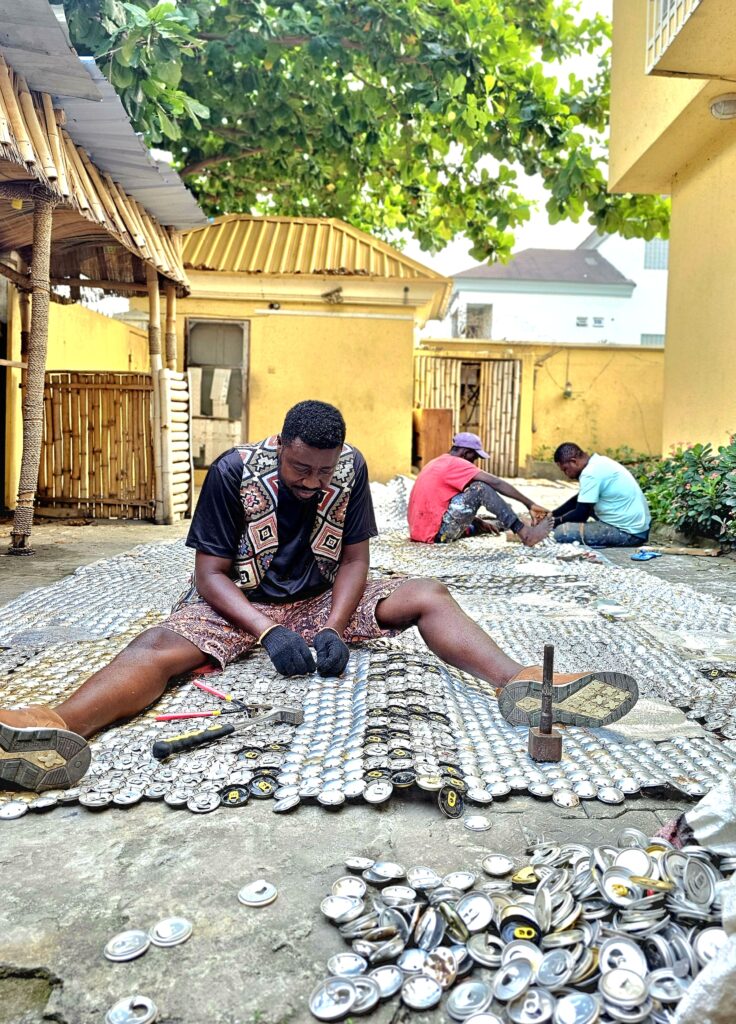
FAB: So, you believe an artist should be a visionary who predicts the future?
Gerald: Absolutely. An artist sees what others can’t. The Egyptians, for example, didn’t just look at the past; they envisioned the future and communicated it through their art. Too often, people expect artists to focus only on current issues. That’s a stereotype used to control us. The moment something becomes a norm, it risks becoming a lie because it’s already in the past. Other fields evolve, but art is often held back because of these rigid expectations. It’s time we move forward.
FAB: Finally, in 200 years, what do you think you’ll be remembered for? What legacy do you want to leave behind?
Gerald: Before, I might have answered differently, but today, my brother, Gerald Chukwuma, wants to be remembered for architecture in Nigeria. I want to create monuments that reflect our culture—structures that will stand the test of time and never be forgotten. My art will live on, of course, and it will find its place in people’s homes. But when it comes to architecture, both the interior and exterior, I want to leave a lasting mark.
From now on, I won’t design any structure without embedding our culture in it. It’s simply not possible for me to do otherwise. Whether it’s a university, a church, or any other building, my culture will be there. If a project doesn’t add anything cultural, I won’t be involved because, as a people, we are losing our identity. Architecture is a subtle but powerful way to reclaim and preserve it.
You know why? Because architecture is something everyone can see. You don’t need to pay for admission or be in a certain social class to experience a building. You don’t need to visit a museum. Anyone can see a building, and that’s what the Europeans, British, and Americans understand. They preserve their monuments; they build on them rather than tear them down.
I don’t sign my art pieces because I don’t want people to say, “Oh, Gerald Chukwuma did this in 1942.” I want my work to be timeless. I don’t date my art, so in 200 years, when people study it, they will have something to explore without attaching a specific period to it. But when it comes to architecture—that’s where my recent focus lies. About a year ago, I, Gerald Chukwuma, made a resolve. Every structure I work on, every functional piece of architecture, will be part of this legacy. Stones and concrete will remain, just as they have for the Egyptians. That’s how we know so much about ancient civilizations—because their structures have stood the test of time.
I recently opened a guest house. The front of it is carved, and the second one I’m working on will have carvings on both the paved walkway and the roof. If you don’t like it, go to a painted house! But for me, we must tell our story through our structures. Those who seek to oppress us don’t want our story told—they want our culture and language to disappear. And our language is already vanishing, since we teach in English in schools. But the structures—those will remain. You can’t take them away. If you don’t like it, you can leave, but you can’t ignore it.
In 200 or 500 years, I want people to look at a building and say, “He was part of this. This is the work of Gerald Chukwuma.” But it’s not just about me. I want people to see that this is Yoruba culture. Whether you’re educated or not, it’s important for people to understand how Yoruba people lived and the language they spoke at the time.
Conclusion
In this final installment of our conversation with Gerald Chukwuma, we’ve witnessed a powerful vision for the future of Nigerian architecture and cultural preservation. Through his candid reflections, Gerald Chukwuma has demonstrated that art isn’t just about commenting on the present—it’s about shaping tomorrow. His transition from traditional art forms to architectural monuments represents more than just a career shift; it embodies a deeper mission to preserve Nigerian culture in structures that will stand the test of time.


